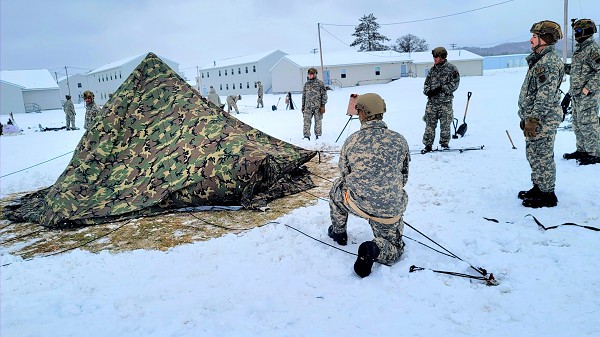
Fort McCoy, Wisconsin. (January 19, 2023): In this photo by Scott T. Sturkol, Airmen with Air National Guard and Air Force Reserve security forces units learn to build an Arctic 10-person tent during a 16-day Cold-Weather Operations Course at Fort McCoy, Wisconsin. More than 50 Airmen from across the Air Force are participating in the event to learn how to survive in arctic conditions. Airmen practiced using snowshoes and moving as a squad over deep snow. The Airmen built cold-weather shelters, practiced survival techniques, and how to properly wear cold-weather gear.
The Cold Weather Operations Course is a 2-week class held 6 times a year at Fort McCoy and is modeled after a similar program taught by the Army Northern Warfare Training Center at Black Rapids, Alaska. Each class begins in the classroom studying survival techniques followed by 14 days practice in the field under frozen conditions.
No ski vacation, the training exposes students to sub-zero temperatures as they learn how-to walk-in snowshoes (a lot harder than it looks!), cross country skiing, and how to maneuver the Ahkio, an open canoe-shaped sled used to pull heavy cargo over snow. Students learn to analyze terrain, interpret the weather, and how to develop winter fighting positions using camouflage and concealment.
Fort McCoy is the largest military outpost in Wisconsin, it provides support and facilities for training more than 100,000 military personnel from all services each year. In 1941, the Army's 76th Division trained at Fort McCoy prior to the Division deploying to Europe to fight the famous Battle of the Bulge. In what Winston Churchill called the “greatest American battle of the war”, Soldiers from the 76th Division helped defeat Adolf Hitler’s last desperate attempt to win the war. Lasting six brutal weeks, the assault took place during frigid weather conditions as some 30 German divisions attacked the battle-fatigued Americans across 85 miles of the densely wooded Ardennes Forest.
When the battle ended, the Americans suffered approximately 19,000 soldiers killed in action, 47,500 wounded, and 23,000-plus missing. About 100,000 Germans were killed, wounded, or captured according to the U.S. Department of Defense.
The success of the 76th Division can, in part, be attributed to the cold weather training they received at Fort McCoy.


